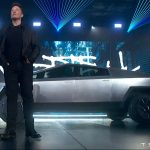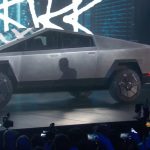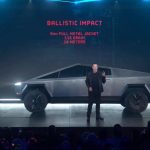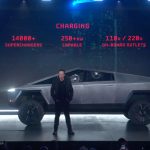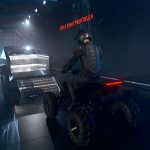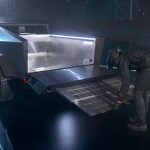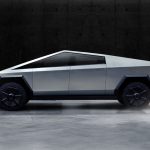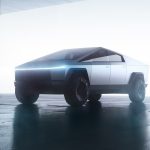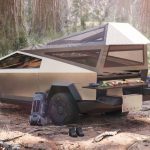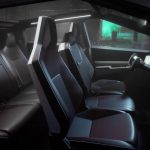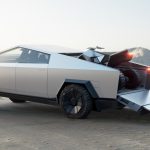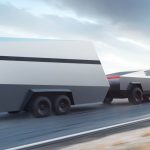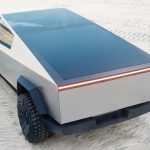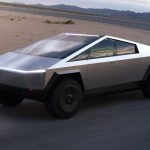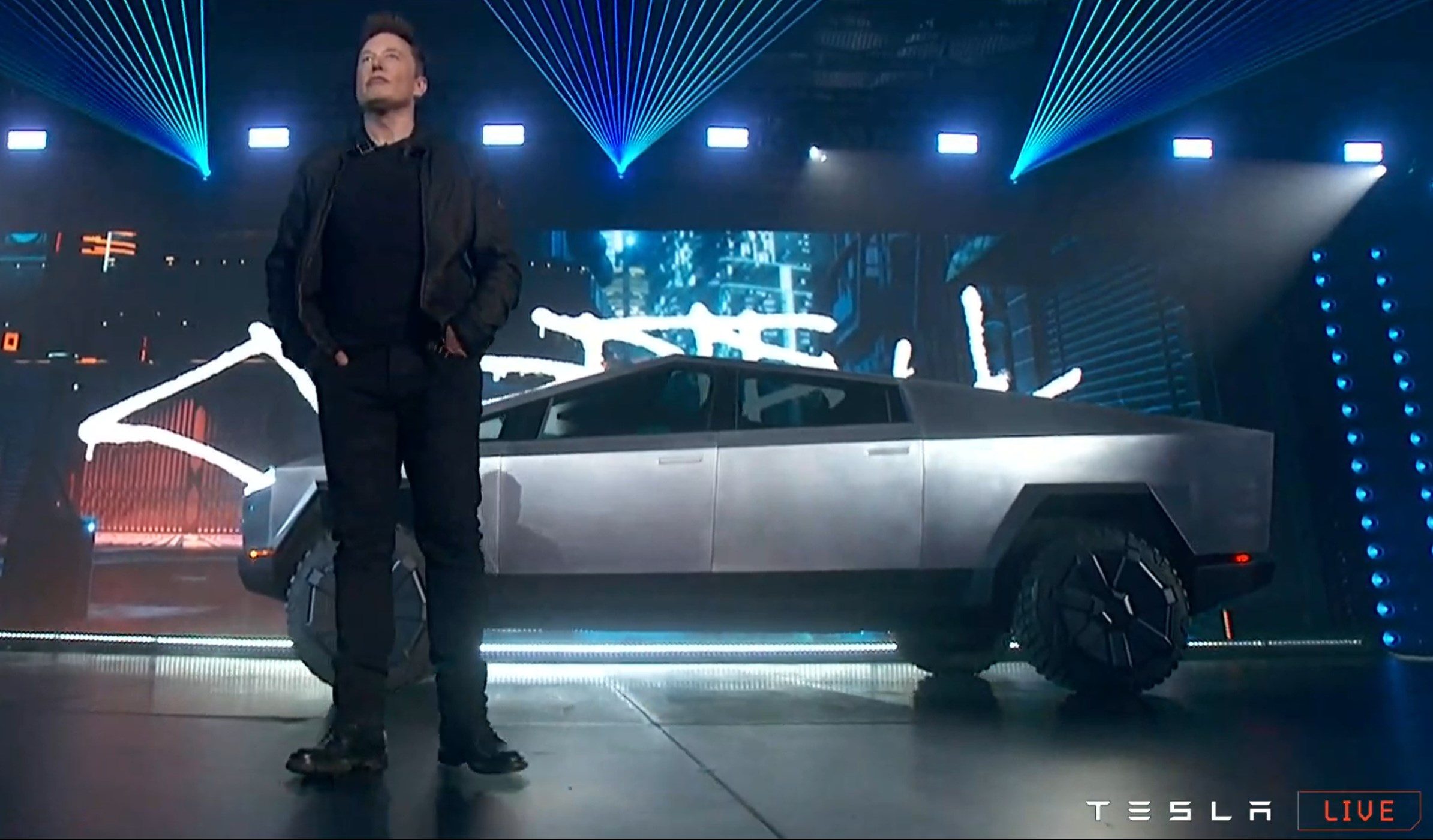

News
Tesla Cybertruck pickup: ultra hard stainless steel, 0-60 in 2.9 secs, 14k lbs towing capacity, and $40k base price
Tesla has revealed its highly-anticipated pickup truck to the public, and it is every bit the monster that CEO Elon Musk has made it out to be. With its aggressive stance, high ground clearance, and massive frame, the Tesla’s CYBRTRK is quite a sight to behold. It also shows that while Tesla has pretty much created stunning city cars until today, the company is every bit as capable of creating a daunting machine that can perform just as well on paved roads as it does on rough terrain.
Design
The Tesla Cybertruck does not look like a traditional pickup. True to Elon Musk’s words, the vehicle does look like a futuristic armored personnel carrier that stepped out of the set of Blade Runner. Its straight sloping roof give the pickup a streamlined yet very unique look. As the Tesla CEO has stated in the past, the Cybertruck won’t look like any other pickup on the road today.
That being said, there are several key design aspects that are notable about the Cybertruck. These include its extremely angular body, its large bed, and its high ground clearance. The Cybertruck also has a thick stainless steel body, which Tesla demonstrated by having a sledgehammer hit the pickup’s door panel. The vehicle is also fitted with Tesla’s Armor Glass, which unfortunately cracked after a large steel ball was thrown at it onstage. The metal ball didn’t go through the glass though, which is a plus.
- Credit: Tesla/YouTube
- (Credit: Tesla)
Specs
Tesla has pretty much mastered the art of keeping the specs of its upcoming vehicles’ secret. As it turns out, the Cybertruck’s performance figures are definitely worth the secrecy, as they are flat-out insane. The vehicle is equipped with a standard single motor and can be upgraded to dual and tri-motors. Just as Musk said, the Cybertruck, despite its size, is quite nimble, thanks to its instant torque and adaptive air suspension that can adjust height to meet the vehicle’s intended purpose. These ultimately allow the Cybertruck to hit 60 mph in just 2.9 seconds, with handling comparable to a Porsche.
Here are other notable specs of the Tesla Cybertruck:
- 250+, 300+, and 500+ miles of range
- 3500 lbs payload
- Towing rating between 7.5k to 14k lbs
- 250 kW charging
- Off-road performance with 35 degrees approach angle, up to 16″ clearance, and 28 degrees departure angle
- 100 cubic feet of exterior storage
- The Cybertruck’s overlanding capabilities as teased by Tesla. (Credit: Tesla)
- (Credit: Tesla)
- Credit: Tesla
Special Features
Pickups are utility vehicles by nature, and as such, they are used primarily for work on locations such as farms or construction sites. Luxury pickups exist that prioritize comfort over utility, but Tesla’s monster pickup has chosen to do both. The interior of the Cybertruck is classic Tesla in the way that it’s minimalist and airy, with plush seats and a massive touchscreen that’s optimized for work and even entertainment. This, however, is only the tip of the iceberg when it comes to the pickup truck’s notable features. Others include:
- 110v/220v onboard outlets
- Full Self-Driving features
- Autopilot as standard
Price
Earlier this year, Elon Musk has mentioned that the Tesla Cybertruck would start at $49,000 at the highest. Tesla has stayed true to its CEO’s words, pricing the futuristic pickup truck very aggressively compared to other EV trucks and ICE-powered luxury pickups. Tesla’s Cybertruck does have a number of higher-priced trims, and these cost substantially more, while offering significantly more.
Here’s the complete pricing of Tesla’s Cybertruck depending on its trim.
- Single Motor RWD – $39,900 before options
- Dual Motor AWD – $49,900 before options
- Tri-Motor AWD – $69,900 before options

News
Tesla Insurance officially expands to new U.S. state
Tesla’s in-house Insurance program first launched back in late 2019, offering a new way to insure the vehicles that was potentially less expensive and could alleviate a lot of the issues people had with claims, as the company could assess and repair the damage itself.
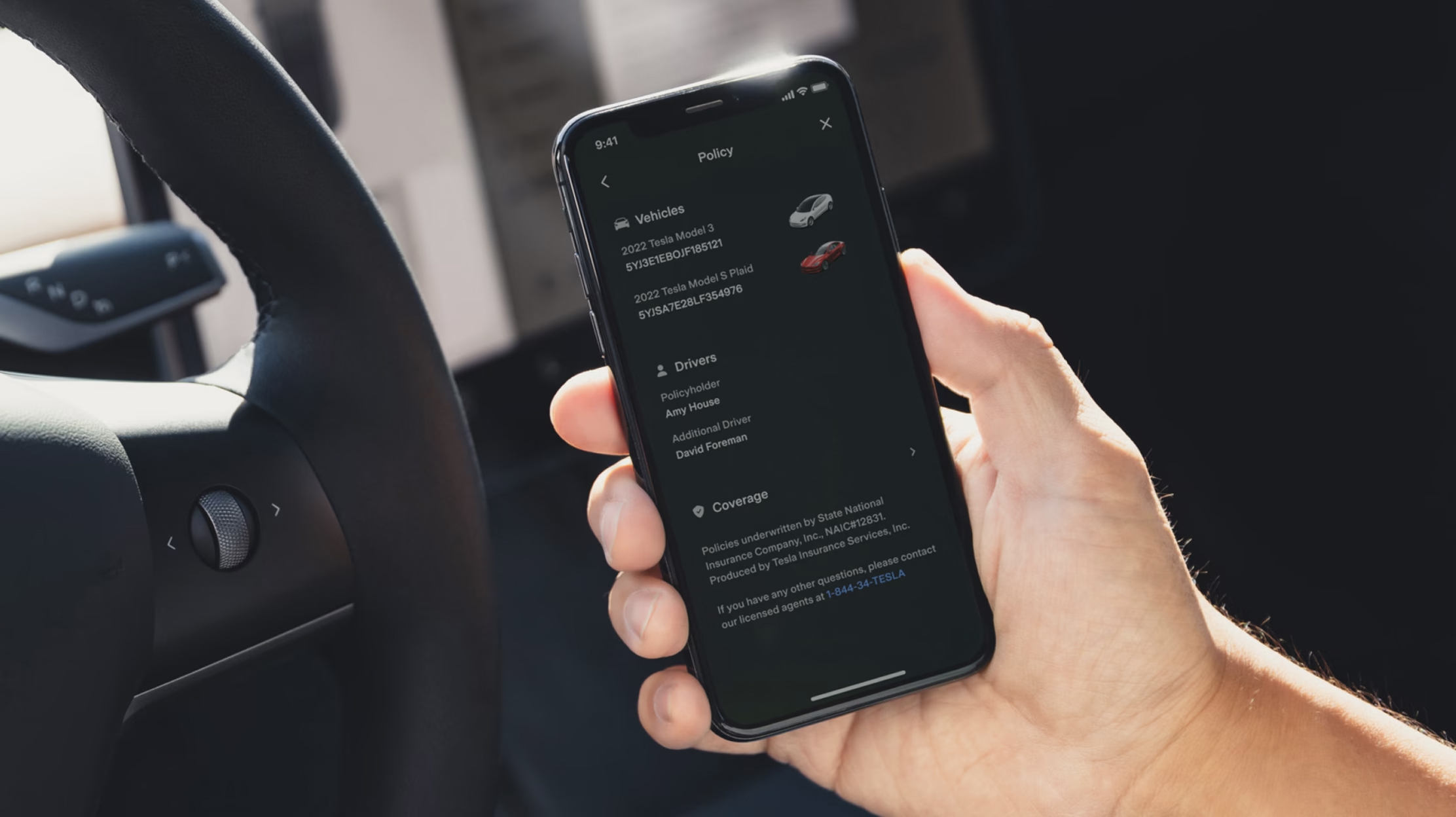
Tesla Insurance has officially expanded to a new U.S. state, its thirteenth since its launch in 2019.
Tesla has confirmed that its in-house Insurance program has officially made its way to Florida, just two months after the company filed to update its Private Passenger Auto program in the state. It had tried to offer its insurance program to drivers in the state back in 2022, but its launch did not happen.
Instead, Tesla refiled the paperwork back in mid-October, which essentially was the move toward initiating the offering this month.
BREAKING: Tesla Insurance has just officially launched in Florida.
This is the first new state to receive @Tesla Insurance in more than 3 years. In total, Tesla insurance is now available in 13 U.S. states (map in thread below of all the states).
Tesla Insurance in Florida uses… pic.twitter.com/bDwh1IV6gD
— Sawyer Merritt (@SawyerMerritt) December 17, 2025
Tesla’s in-house Insurance program first launched back in late 2019, offering a new way to insure the vehicles that was potentially less expensive and could alleviate a lot of the issues people had with claims, as the company could assess and repair the damage itself.
It has expanded to new states since 2019, but Florida presents a particularly interesting challenge for Tesla, as the company’s entry into the state is particularly noteworthy given its unique insurance landscape, characterized by high premiums due to frequent natural disasters, dense traffic, and a no-fault system.
Annual average premiums for Florida drivers hover around $4,000 per year, well above the national average. Tesla’s insurance program could disrupt this, especially for EV enthusiasts. The state’s growing EV adoption, fueled by incentives and infrastructure development, aligns perfectly with Tesla’s ecosystem.
Moreover, there are more ways to have cars repaired, and features like comprehensive coverage for battery damage and roadside assistance tailored to EVs address those common painpoints that owners have.
However, there are some challenges that still remain. Florida’s susceptibility to hurricanes raises questions about how Tesla will handle claims during disasters.
Looking ahead, Tesla’s expansion of its insurance program signals the company’s ambition to continue vertically integrating its services, including coverage of its vehicles. Reducing dependency on third-party insurers only makes things simpler for the company’s automotive division, as well as for its customers.
News
Tesla Full Self-Driving gets sparkling review from South Korean politician
“Having already ridden in an unmanned robotaxi, the novelty wasn’t as strong for me, but it drives just as well as most people do. It already feels like a completed technology, which gives me a lot to think about.”
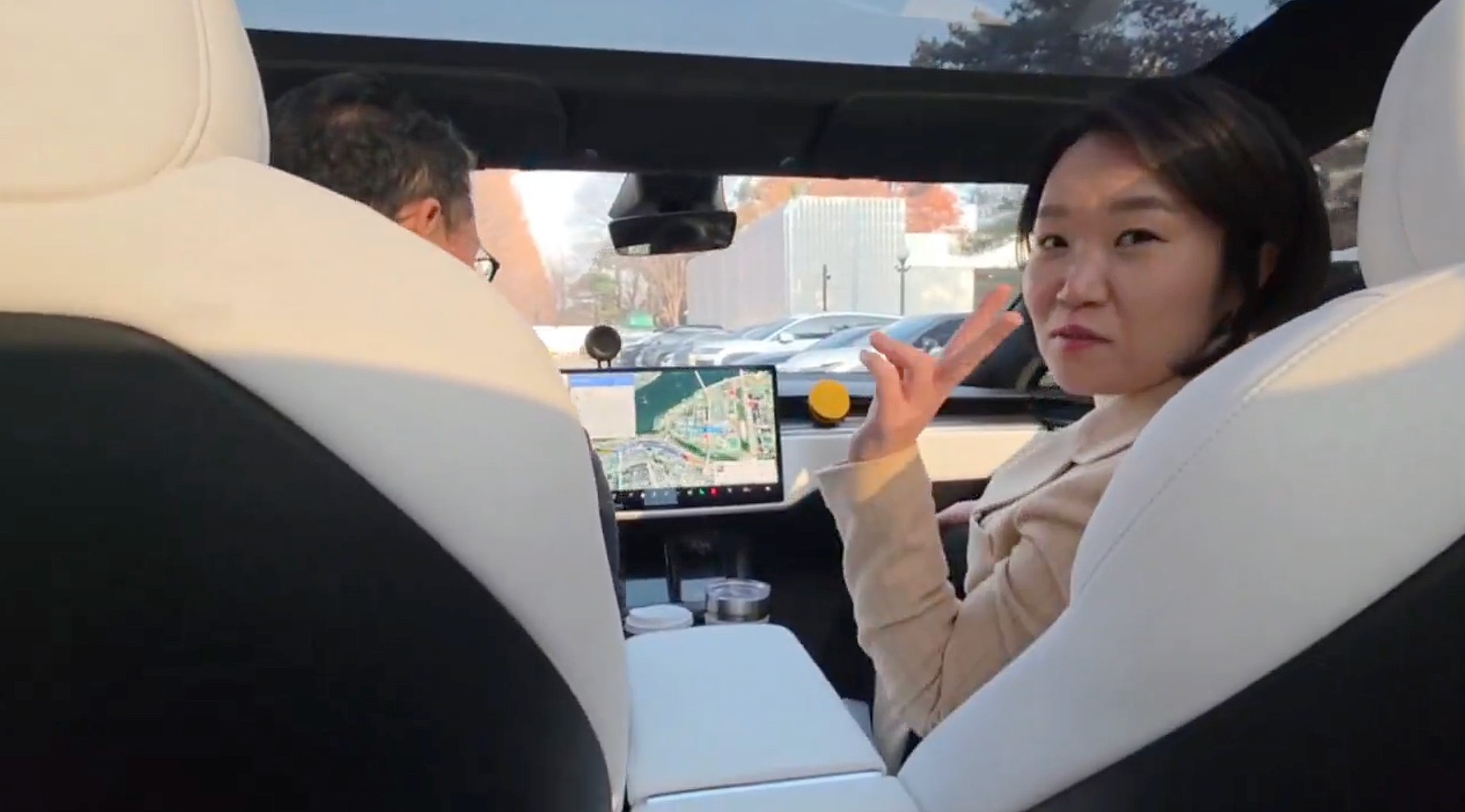
Tesla Full Self-Driving got its first sparkling review from South Korean politician Lee So-young, a member of the country’s National Assembly, earlier this week.
Lee is a member of the Strategy and Finance Committee in South Korea and is a proponent of sustainable technologies and their applications in both residential and commercial settings. For the first time, Lee was able to utilize Tesla’s Full Self-Driving technology as it launched in the country in late November.
Her thoughts on the suite were complimentary to the suite, stating that “it drives just as well as most people do,” and that “it already feels like a completed technology.”
드디어 오늘, 서울에서 테슬라 FSD 체험 했습니다.
JiDal Papa님의 모델S 협찬에 힘입어^^ 파파님 정말 감사합니다.
국회 -> 망원시장 -> 홍익대 -> 국회 복귀 코스였고요.
이미 무인 로보택시를 타봐서 그런지 신기함은
덜했지만, 웬만한 사람만큼 운전을 잘하네요.이미 완성된 기술이라고… pic.twitter.com/8pAidHBpRG
— 이소영 국회의원 (Soyoung Lee) (@im_soyounglee) December 17, 2025
Her translated post says:
“Finally, today I got to experience Tesla FSD in Seoul. Thanks to the Model S sponsored by JiDal Papa^^, I’m truly grateful to Papa. The route was from the National Assembly -> Mangwon Market -> Hongik University -> back to the National Assembly. Having already ridden in an unmanned robotaxi, the novelty wasn’t as strong for me, but it drives just as well as most people do. It already feels like a completed technology, which gives me a lot to think about. Once it actually spreads into widespread use, I feel like our daily lives are going to change a lot. Even I, with my license gathering dust in a drawer, don’t see much reason to learn to drive a manual anymore.”
Tesla Full Self-Driving officially landed in South Korea in late November, with the initial launch being one of Tesla’s most recent, v14.1.4.
It marked the seventh country in which Tesla was able to enable the driver assistance suite, following the United States, Puerto Rico, Canada, China, Mexico, Australia, and New Zealand.
It is important to see politicians and figures in power try new technologies, especially ones that are widely popular in other regions of the world and could potentially revolutionize how people travel globally.
News
Tesla dispels reports of ‘sales suspension’ in California
“This was a “consumer protection” order about the use of the term “Autopilot” in a case where not one single customer came forward to say there’s a problem.
Sales in California will continue uninterrupted.”

Tesla has dispelled reports that it is facing a thirty-day sales suspension in California after the state’s Department of Motor Vehicles (DMV) issued a penalty to the company after a judge ruled it “misled consumers about its driver-assistance technology.”
On Tuesday, Bloomberg reported that the California DMV was planning to adopt the penalty but decided to put it on ice for ninety days, giving Tesla an opportunity to “come into compliance.”
Tesla enters interesting situation with Full Self-Driving in California
Tesla responded to the report on Tuesday evening, after it came out, stating that this was a “consumer protection” order that was brought up over its use of the term “Autopilot.”
The company said “not one single customer came forward to say there’s a problem,” yet a judge and the DMV determined it was, so they want to apply the penalty if Tesla doesn’t oblige.
However, Tesla said that its sales operations in California “will continue uninterrupted.”
It confirmed this in an X post on Tuesday night:
This was a “consumer protection” order about the use of the term “Autopilot” in a case where not one single customer came forward to say there’s a problem.
Sales in California will continue uninterrupted.
— Tesla North America (@tesla_na) December 17, 2025
The report and the decision by the DMV and Judge involved sparked outrage from the Tesla community, who stated that it should do its best to get out of California.
One X post said California “didn’t deserve” what Tesla had done for it in terms of employment, engineering, and innovation.
Tesla has used Autopilot and Full Self-Driving for years, but it did add the term “(Supervised)” to the end of the FSD suite earlier this year, potentially aiming to protect itself from instances like this one.
This is the first primary dispute over the terminology of Full Self-Driving, but it has undergone some scrutiny at the federal level, as some government officials have claimed the suite has “deceptive” naming. Previous Transportation Secretary Pete Buttigieg was vocally critical of the use of the name “Full Self-Driving,” as well as “Autopilot.”
